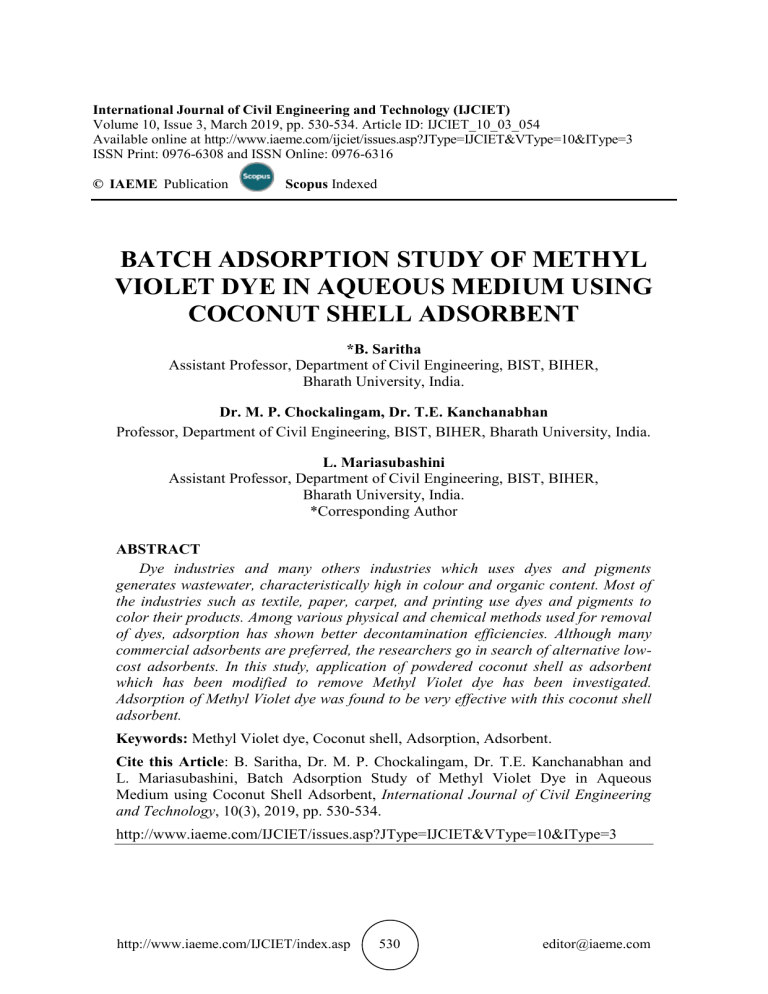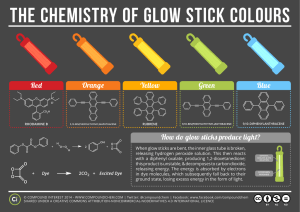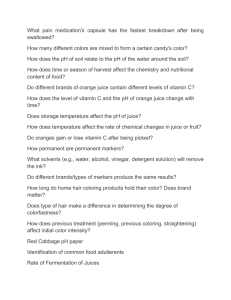BATCH ADSORPTION STUDY OF METHYL VIOLET DYE IN AQUEOUS MEDIUM USING COCONUT SHELL ADSORBENT
advertisement

International Journal of Civil Engineering and Technology (IJCIET) Volume 10, Issue 3, March 2019, pp. 530-534. Article ID: IJCIET_10_03_054 Available online at http://www.iaeme.com/ijciet/issues.asp?JType=IJCIET&VType=10&IType=3 ISSN Print: 0976-6308 and ISSN Online: 0976-6316 © IAEME Publication Scopus Indexed BATCH ADSORPTION STUDY OF METHYL VIOLET DYE IN AQUEOUS MEDIUM USING COCONUT SHELL ADSORBENT *B. Saritha Assistant Professor, Department of Civil Engineering, BIST, BIHER, Bharath University, India. Dr. M. P. Chockalingam, Dr. T.E. Kanchanabhan Professor, Department of Civil Engineering, BIST, BIHER, Bharath University, India. L. Mariasubashini Assistant Professor, Department of Civil Engineering, BIST, BIHER, Bharath University, India. *Corresponding Author ABSTRACT Dye industries and many others industries which uses dyes and pigments generates wastewater, characteristically high in colour and organic content. Most of the industries such as textile, paper, carpet, and printing use dyes and pigments to color their products. Among various physical and chemical methods used for removal of dyes, adsorption has shown better decontamination efficiencies. Although many commercial adsorbents are preferred, the researchers go in search of alternative lowcost adsorbents. In this study, application of powdered coconut shell as adsorbent which has been modified to remove Methyl Violet dye has been investigated. Adsorption of Methyl Violet dye was found to be very effective with this coconut shell adsorbent. Keywords: Methyl Violet dye, Coconut shell, Adsorption, Adsorbent. Cite this Article: B. Saritha, Dr. M. P. Chockalingam, Dr. T.E. Kanchanabhan and L. Mariasubashini, Batch Adsorption Study of Methyl Violet Dye in Aqueous Medium using Coconut Shell Adsorbent, International Journal of Civil Engineering and Technology, 10(3), 2019, pp. 530-534. http://www.iaeme.com/IJCIET/issues.asp?JType=IJCIET&VType=10&IType=3 http://www.iaeme.com/IJCIET/index.asp 530 editor@iaeme.com B. Saritha, Dr. M. P. Chockalingam, Dr. T.E. Kanchanabhan and L. Mariasubashini 1. INTRODUCTION Development of industries has led to the problem of many types of pollution. Because of scarcity of water in many areas we are in need to preserve the available water. When population has started to increase, demand also increased. Earlier it was believed that the water bodies like oceans were very large to pollute. Many types of wastes from industries are produced by various processes in industries which releases materials that are noted as useless while manufacturing a product. Industrial wastes are in various forms like toxic waste, chemical waste, industrial solid waste and municipal solid waste. Many industries discharge wastewater including coloring dyes as sediments which leads to various many health hazards. Most of the dyes used are not biodegradable. They cause water pollution and severely affects the environment mainly aquatic ecosystem. Adsorption is the best processes to treat dye wastewater. Previously only widely used adsorbents were in practice for treatment purposes but many researches are now conducted to use cheaply available natural materials . 2. METHODOLOGY 2.1. Coconut Shell Coconut Shell was cleaned with water and dried. Then powdered and seived. Then soaked in dilute H2SO4.and again dried oven. Now the chemically modified natural coconut Shell was obtained as adsorbent. 2.2. Methyl Violet dye solution Methyl Violet dye sample was made by mixing the dye in water. 2.3. Experimental batch mode The experiment was conducted in an orbital shaking incubator and 50 mg of coconut shell powder is taken with 20 ml of Methyl Violet dye aqueous solution. After certain time, concentration of Methyl Violet dye was analyzed. 3. DISCUSSIONS There are many evaluation studies included for determining the the operational indices such as temperature, pH, moisture content, compost maturity indices like carbon, nitrogen, C/N ratio, sulphur, Fourier Transform Infra-Red (FTIR) analysis and Scanning Electron Microscope (SEM) images in any treatment process. In this study the effect of contact time, pH are varied. (T E Kanchanabhan et al, 2011) 3.1. Study of contact time The study of contact time was conducted with initial Methyl Violet dye concentration of 10mg/L and with 50mg of adsorbent and pH adjustments. The adsorptive removal of Methyl Violet dye by coconut shell without varying concentration initially has been shown in fig.1. There was no change in removal of dye after 100 minutes. http://www.iaeme.com/IJCIET/index.asp 531 editor@iaeme.com Batch Adsorption Study of Methyl Violet Dye in Aqueous Medium using Coconut Shell Adsorbent Figure 1 Study of time of contact on basic dye Methyl Violet dye Adsorption using Coconut Shell 3.2. Study of pH The variation of pH was conducted with 10mg/L of Methyl Violet dye. The values of pH were between 2 to 12. This resulted in tremendous adsorptive removal of Methyl Violet dye. This clearly shows that ions like H+ or OH- helps in Methyl Violet dye adsorption by coconut shell. Figure 2 Study of variation of pH on adsorptive removal of Methyl Violet dye by Coconut Shell 3.3. Study of variation of Methyl Violet dye concentration The concentration of Methyl Violet dye was varied. It is significantly proved that at low concentration, the dye molecules to the available surface area is very less and the adsorption becomes independent of dye. But at large number of dye molecules the available places becomes low and thus the adsorptive removal of Methyl Violet dye is depends on its dye molecules initially. http://www.iaeme.com/IJCIET/index.asp 532 editor@iaeme.com B. Saritha, Dr. M. P. Chockalingam, Dr. T.E. Kanchanabhan and L. Mariasubashini Figure 3 Study of initial concentration on adsorptive removal of Methyl Violet dye by Coconut Shell 3.4. Study of Coconut shell adsorbent dosage The study of dosage of coconut shell on adsorptive removal of dye at same concentration was studied by varying dosage of coconut shell from 50 mg to 500mg. It shows that adsorptive removal increases with increase in the coconut shell dosage. It is due to surface area of Coconut Shell and due to many sites of adsorption. Figure 4 Study of dosage of coconut shell on adsorptive removal of Methyl Violet dye 4. CONCLUSION Adsorptive removal of Methyl Violet dye with chemically modified Coconut shell has been conducted and observations were made. The rate of adsorptive removal becomes less with increase in concentration of dye initially. Optimum contact time after adsorptive removal was 100 minutes. The adsorptive removal of Methyl Violet dye is due to variation in pH. Adsorption of Methyl Violet dye seems to be higher with time. Initially, the adsorptive removal of Methyl Violet dye is rapid due to large number of free sites and later it decreases due to saturation of these active sites. http://www.iaeme.com/IJCIET/index.asp 533 editor@iaeme.com Batch Adsorption Study of Methyl Violet Dye in Aqueous Medium using Coconut Shell Adsorbent REFERENCES [1] [2] [3] [4] [5] [6] [7] [8] [9] [10] [11] [12] [13] [14] [15] Emad N. El Qada, Stephen J. Allen, Gavin M. Walker. (2006). “Adsorption of Rhodamine – B onto activated carbon produced from steam activated bituminous coal.” Chemical Engineering Journal,124, 103–110. 4.Grabowska EwaLorenc, GryglewiczGra zyna. (2005). “Adsorption characteristics of Congo red on coal-based mesoporous activated carbon.” Dyes and Pigments,74,34-40. I.A. Rahman, B. Saad, S. Shaidan, E.S. Sya Rizal. (2005). “Adsorption characteristics of Rhodamine – B on activated carbon derived from rice husks produced by chemical– Thermal process.” Bioresource Technology, 96 ,1578–1583. Khan A. Tabrez, Imran Ali, Singh VedVati and Sharma Sangeeta. (2009). “Utilization of Fly ash as Low-Cost Adsorbent for the Removal of Rhodamine – B Dye from Textile Wastewater.” Journal of environmental protection science, 3,11 – 22. M. Hema and P. Martin Deva Prasath(.2009). “Adsorption of Rhodamine – B onto carbon Prepared from brasses bark.” The Arabian Journal for Science and Engineering, 34, 2A R. A. Shawabkeh and E. S. M. Abu-Nameh.(2007). “Absorption of Phenol and Rhodamine – B by Activated Carbon from Pecan Shells.” Colloid Journal, 69,3, 355– 359. Raghavacharya C (1997) Colour Removal from Industrial effluents – A comparative Review of available technologies.” Chem. Eng. World 32(7),53–54. V.K.Garg,MoirangthemAmita,RakeshKumar,RenukaGupta.(2004).“Basic dye (Rhodamine –B) removal from simulated wastewater by adsorption using Indian Rosewood sawdust: a tiMOer industry waste.” Dyes and Pigments, 63,243-250. Y.Onal,C.Akmil-Basar,DidemEren, CigdemSarici-O zdemir, TolgaDepci.(2006). “Adsorption kinetics of Rhodamine – B onto activated carbon prepared from Tunc¸bilek lignite.”Journal of Hazardous Materials B,128,150–157. Banuraman Saritha and Meikandaan T.P., Treatability study of tannery effluent by enhanced primary treatment, Int. J. Mod. Engin. Res. (IJMER), 3(1), 119-122, (2013). Saritha B, Madavan V. Study of Ground Water in Perungudi Area of Chennai: Correlation with Physico-Chemical Parameters. Civil & Environ. Res. 2011;1(1):23-31. YaminYasin, MohdZobir Hussein and FaujanHj Ahmad. (2007). “Adsorption of Rhodamine – B onto Treated Activated Carbon.”The Malaysian Journal of Analytical sciences 11,11,400 – 406. Bhattacharyya K.G. and Sharma A. (2005). “Kinetics and mechanism of removal of Rhodamine – B by adsorption on various carbons-a comparative study.” Dyes and pigments, 51, 25-40. Kannan N and Meenakshisundaram M. (2002). “Adsorption of Congo red on Activated carbons: A comparative study.” Water, Air and Soil Pollution,138,289 – 305. T. E. Kanchanabhan, Mohaideen. J. Abbas, Kumar Ganesh, Sairam, B, Lavanya, (2011), Elemental and Spectroscopic Analysis of Organic Matter Transformation during Forced Aeration of In-Vessel Composting, Asian Journal of Water, Environment and Pollution, vol. 8, no. 1, pp. 63-71, 2011 http://www.iaeme.com/IJCIET/index.asp 534 editor@iaeme.com


